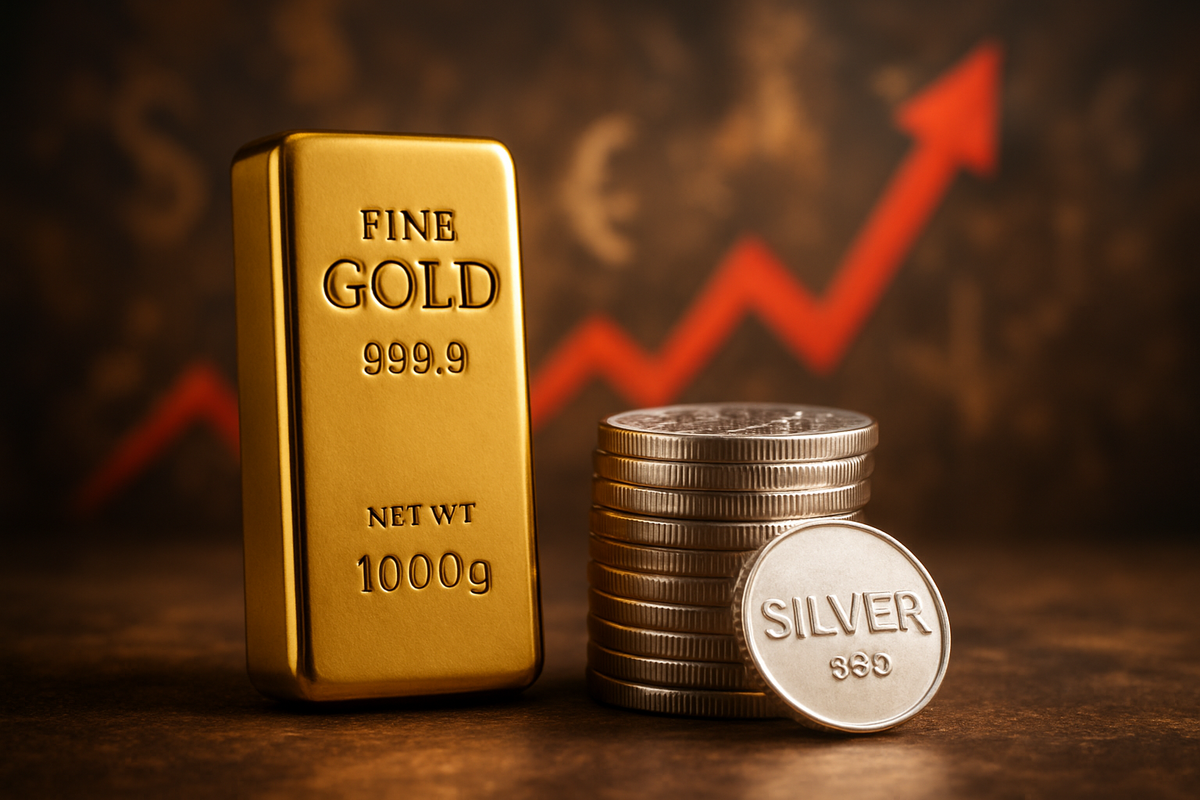Financial News
The Golden Shield: How Gold and Silver are Poised to Shine Amidst the Looming Inflation Trade

As of November 2025, the global financial landscape continues to grapple with persistent inflationary pressures, prompting investors to increasingly turn their attention to the "inflation trade." This strategic reallocation of capital is designed to either profit from or protect wealth against rising price levels, with commodities historically serving as a favored haven. Amidst this backdrop, gold and silver are emerging as frontrunners, reinforcing their age-old reputation as reliable hedges against the erosion of purchasing power. The significant surges in their prices over the past few years underscore a growing market conviction that these precious metals will play a pivotal role in safeguarding portfolios in an enduring inflationary environment.
The immediate implications of this burgeoning inflation trade are profound. With central banks globally navigating a delicate balance between controlling inflation and fostering economic growth, the appeal of tangible assets like gold and silver intensifies. Investors are seeking refuge from the volatility seen in traditional assets and the quiet depreciation of cash. The recent performance of these metals—gold skyrocketing over 125% and silver over 116% since 2021—serves as a clear signal of their perceived value in these uncertain times, suggesting a continued upward trajectory as long as inflation remains a dominant economic theme.
Inflation's Persistent Grip and Precious Metals' Resurgence
The current economic climate, as of November 17, 2025, is defined by inflation remaining a stubborn and significant factor. The U.S. Federal Reserve has maintained its benchmark interest rates between 4.25-4.50% in an effort to tame price increases, yet still projects potential inflation acceleration to 3.1% later in the year. The twelve-month Consumer Price Index (CPI) through September 2025 stood at 3%, while the Personal Consumption Expenditures (PCE) inflation, the Federal Open Market Committee's (FOMC) preferred measure, hovered around 2.8%—both stubbornly above the Fed's 2% target. Across the Atlantic, the European Commission's Autumn 2025 Economic Forecast anticipates euro area inflation to decline to 2.1% in 2025, stabilizing around 2% thereafter, with the broader EU experiencing slightly higher figures.
This persistent inflationary backdrop has been a key driver for the remarkable performance of precious metals. From 2021 to November 2025, gold prices have surged dramatically, climbing from an average of $1,800 per ounce to an impressive $4,248.30, marking a staggering 125.7% gain. Silver has mirrored this upward trend, rising from $25 per ounce to $54.09, delivering a robust 116.3% return over the same period. Notably, 2025 has seen gold achieve new record highs, surpassing $3,499 per ounce and even breaching the $4,000 mark, highlighting the strong investor demand.
The timeline leading up to this moment has been characterized by an inflation surge beginning in 2021, triggered by a confluence of factors including supply chain disruptions, robust consumer demand fueled by fiscal stimulus, and geopolitical tensions. Central banks globally responded with aggressive monetary tightening cycles, yet the battle against inflation has proven more protracted than initially anticipated. This prolonged period of elevated prices has led to a re-evaluation of traditional diversified portfolios, as the positive correlation between stocks and bonds, a hallmark of inflationary periods, has challenged conventional hedging strategies. Key stakeholders, including central banks like the Federal Reserve, the European Central Bank, and individual investors, are all grappling with the implications of this new economic reality. Initial market reactions have been mixed; while US equities experienced a rally partly due to a government shutdown deal, megacap tech stocks faced losses amidst jitters surrounding artificial intelligence (AI) spending, further emphasizing the shift in market dynamics towards assets perceived as inflation-resistant.
Companies Poised to Benefit from the Precious Metals Boom
The resurgence of gold and silver prices in an inflationary environment creates significant opportunities for companies operating within the precious metals sector, while also posing challenges for others. Primarily, precious metal mining companies stand to gain substantially. Higher commodity prices directly translate into increased revenues and potentially wider profit margins, assuming their operating costs do not rise proportionally.
Companies like Barrick Gold Corporation (NYSE: GOLD) and Newmont Corporation (NYSE: NEM), two of the world's largest gold producers, are well-positioned. Their extensive mining operations and established production capacities mean that every upward tick in gold prices significantly boosts their financial outlook. Similarly, major silver producers such as Pan American Silver Corp. (NASDAQ: PAAS) and Fresnillo Plc (LSE: FRES) would see their profitability enhanced by rising silver values. These companies benefit from the intrinsic value of their mined resources appreciating, making their existing reserves more valuable and justifying further exploration and development efforts.
Beyond the miners, Exchange Traded Funds (ETFs) that track precious metals or hold physical gold and silver are also direct beneficiaries. The SPDR Gold Shares (NYSEARCA: GLD) and the iShares Silver Trust (NYSEARCA: SLV) provide investors with accessible avenues to participate in the inflation trade without directly owning physical bullion. As investor demand for inflation hedges grows, inflows into these ETFs are likely to increase, further supporting their asset values. Furthermore, companies involved in the refining, trading, and storage of precious metals could also experience increased business activity.
Conversely, companies heavily reliant on consumer discretionary spending or those with high input costs that cannot easily be passed on to consumers might face headwinds. While not directly losing from the rise in gold and silver, their relative attractiveness as investments could diminish as capital flows into inflation-resistant assets. However, for the precious metals sector, the "inflation trade" presents a clear and compelling tailwind, driving investor interest and potentially leading to stronger financial performance for producers and related investment vehicles.
Broader Implications and Historical Parallels
The current "inflation trade" and the ascendance of gold and silver are not isolated events but rather fit into broader industry trends driven by macro-economic shifts. One significant trend is the challenge to traditional portfolio diversification. The historical inverse correlation between stocks and bonds, which typically offered a balanced hedge, has been disrupted by persistent inflation. As the research indicates, inflation has led to a positive correlation between these asset classes, compelling investors to seek alternative safe havens. Gold and silver, with their low correlation to traditional markets, are filling this void, offering a crucial diversification component. This shift implies that portfolio managers and retail investors alike are re-evaluating their asset allocation strategies, moving away from purely financial assets towards tangible ones.
The ripple effects extend to competitors and partners across various sectors. For instance, while precious metal miners benefit, industries with high energy or raw material input costs that cannot easily pass these costs onto consumers may struggle. Regulatory and policy implications are also significant. Central banks, particularly the Federal Reserve, are under immense pressure to manage inflation without stifling economic growth. Their interest rate decisions directly impact the opportunity cost of holding non-yielding assets like gold. Lower or negative real interest rates enhance gold's appeal, while aggressively high rates can diminish it. The global coordination (or lack thereof) among central banks in combating inflation will continue to shape the environment for precious metals.
Historically, the current situation bears striking resemblances to the stagflationary period of the 1970s. During that decade, gold delivered an astonishing 2,329% return from 1971 to 1980, while silver also skyrocketed by 1,546% between 1969 and 1979, both significantly outpacing inflation. This historical precedent provides a powerful narrative for gold and silver as robust inflation hedges. However, it's crucial to note that gold's performance isn't always linear; it saw declines in the early 1980s despite persistent inflation due to high interest rates. More recently, gold's surge during the 2008 financial crisis and the COVID-19 pandemic further cemented its role as a safe haven during periods of economic uncertainty and extensive monetary stimulus. Silver's dual role, with significant industrial demand, introduces a layer of complexity, making its price more sensitive to global industrial growth alongside its safe-haven appeal.
Navigating the Future: Opportunities and Challenges
Looking ahead, the "inflation trade" is expected to continue shaping market dynamics, presenting both short-term and long-term possibilities for gold and silver. In the short term, as long as inflation remains elevated above central bank targets and real interest rates stay low or negative, the appeal of precious metals as a store of value will likely persist. Expert predictions for gold prices in 2025 are largely optimistic, with some analysts, like Goldman Sachs, projecting gold to reach $2,900 by early 2025, and others, such as Alan Hibbard of GoldSilver, anticipating returns of at least 20%, potentially reaching 40%. Some even foresee gold approaching or exceeding $4,000 an ounce if high inflation endures or central banks pivot to lower interest rates.
For silver, its dual nature as both a monetary metal and an industrial commodity means its trajectory will be influenced by both inflation hedging demand and the health of the global economy. Continued growth in sectors like solar panels, electronics, and electric vehicles could provide additional tailwinds for silver, even beyond its inflation-hedging properties. Potential strategic pivots for investors include rebalancing portfolios to include a higher allocation to precious metals, especially given their low correlation with traditional assets. This adaptation is crucial in an environment where the traditional 60/40 stock-bond portfolio might offer diminished diversification benefits.
Market opportunities could emerge from increased volatility in other asset classes, driving further capital into the perceived safety of gold and silver. However, challenges also exist. A sudden and decisive drop in inflation, coupled with significantly higher real interest rates, could dampen the appeal of non-yielding assets. Geopolitical tensions, currency fluctuations, and unexpected policy shifts by central banks also introduce elements of uncertainty. Potential scenarios range from a continued "soft landing" where inflation gradually recedes but remains elevated, to a more aggressive tightening cycle that could temporarily pressure precious metals. The long-term outlook, however, remains robust for gold and silver, particularly if global debt levels and the propensity for monetary expansion continue, reinforcing their role as fundamental stores of wealth.
The Enduring Significance of Precious Metals in a New Era
The looming "inflation trade" and the subsequent surge in gold and silver prices represent a critical juncture for financial markets, underscoring the enduring significance of these precious metals. The key takeaway is that in an era of persistent inflation and challenged traditional diversification strategies, gold and silver have reasserted their role as vital hedges against the erosion of purchasing power and as safe havens during economic uncertainty. Their remarkable performance since 2021, with gold surpassing $4,000 an ounce and silver climbing above $50, is a testament to their perceived value by investors seeking to preserve wealth.
Moving forward, the market will likely remain highly sensitive to inflation data, central bank rhetoric, and real interest rate movements. Investors should assess their portfolios for inflation risk and consider strategic allocations to precious metals as part of a broader, diversified approach. While experts generally concur on the positive outlook for gold and silver in the current environment, it's crucial to remember that their effectiveness as hedges can vary over different time horizons and economic cycles. Gold's long-term correlation with inflation is strong, but short-term movements can be influenced by other factors. Silver, with its industrial demand component, introduces additional layers of volatility and opportunity.
The lasting impact of this period will likely be a renewed appreciation for tangible assets and a fundamental shift in how investors approach portfolio construction in a world where inflation is no longer a distant threat but a palpable reality. What investors should watch for in the coming months includes continued inflation reports, the Federal Reserve's stance on interest rates, global economic growth indicators (which will influence silver's industrial demand), and any significant geopolitical developments. These factors will collectively dictate the trajectory of gold and silver, solidifying their position as an indispensable component of an inflation-aware investment strategy.
This content is intended for informational purposes only and is not financial advice
More News
View More




Recent Quotes
View More
Quotes delayed at least 20 minutes.
By accessing this page, you agree to the Privacy Policy and Terms Of Service.



